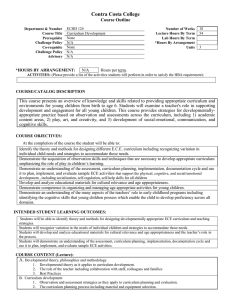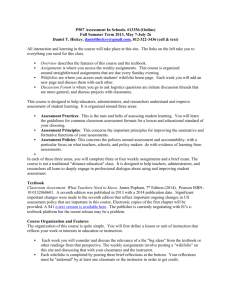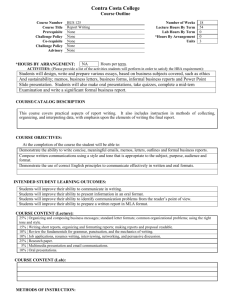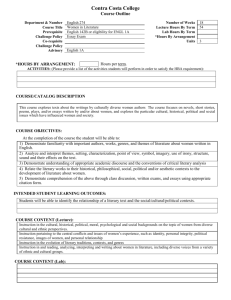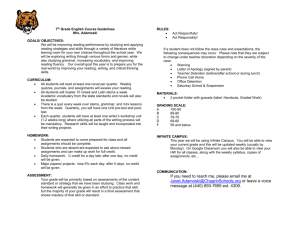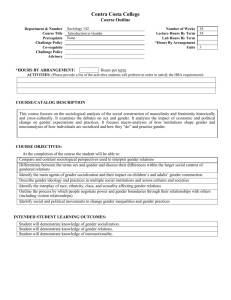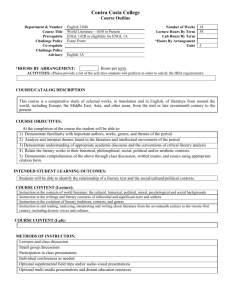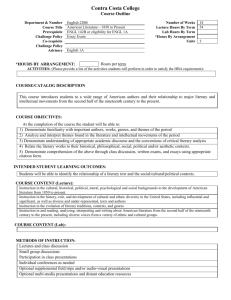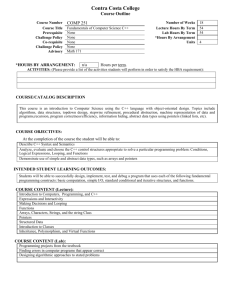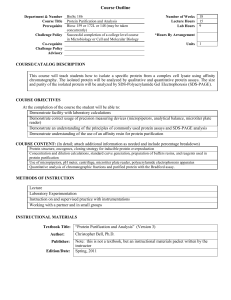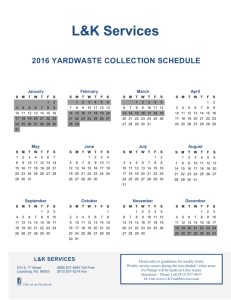CONTENT REVIEW CHECKLIST
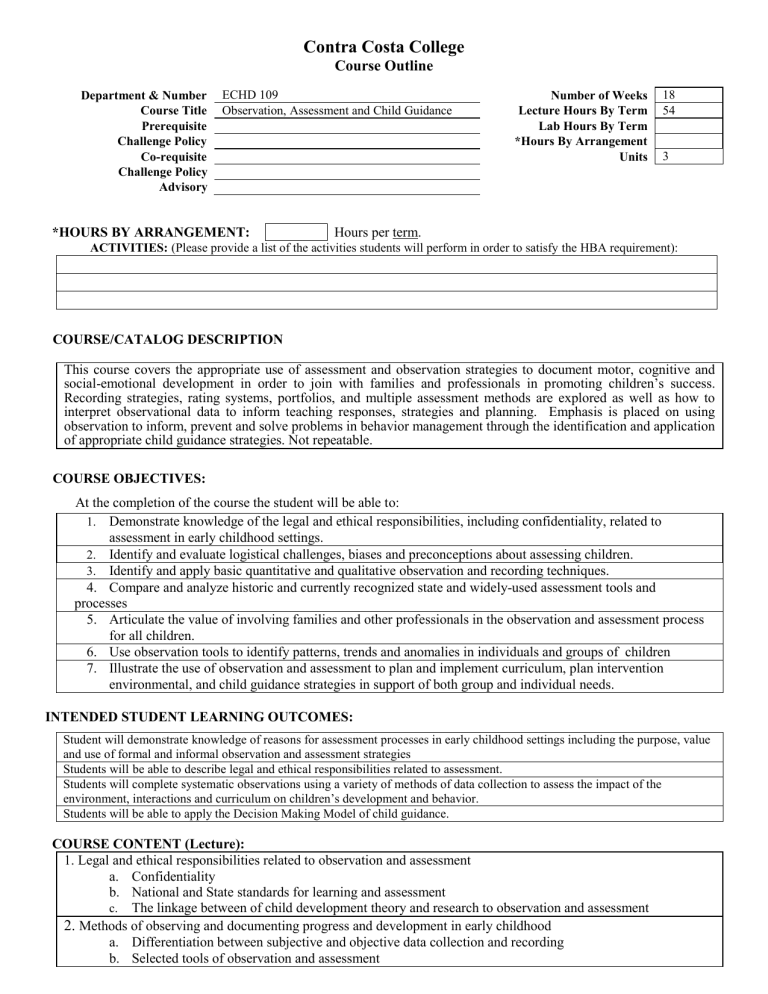
Contra Costa College
Course Outline
Department & Number ECHD 109 Number of Weeks 18
Course Title Observation, Assessment and Child Guidance Lecture Hours By Term 54
Prerequisite Lab Hours By Term
Challenge Policy
Co-requisite
Challenge Policy
Advisory
*Hours By Arrangement
Units 3
*HOURS BY ARRANGEMENT: Hours per term.
ACTIVITIES: (Please provide a list of the activities students will perform in order to satisfy the HBA requirement):
COURSE/CATALOG DESCRIPTION
This course covers the appropriate use of assessment and observation strategies to document motor, cognitive and social-emotional development in order to join with families and professionals in promoting children’s success.
Recording strategies, rating systems, portfolios, and multiple assessment methods are explored as well as how to interpret observational data to inform teaching responses, strategies and planning. Emphasis is placed on using observation to inform, prevent and solve problems in behavior management through the identification and application of appropriate child guidance strategies. Not repeatable.
COURSE OBJECTIVES:
At the completion of the course the student will be able to:
1.
Demonstrate knowledge of the legal and ethical responsibilities, including confidentiality, related to assessment in early childhood settings.
Identify and evaluate logistical challenges, biases and preconceptions about assessing children.
2.
3.
Identify and apply basic quantitative and qualitative observation and recording techniques.
4.
Compare and analyze historic and currently recognized state and widely-used assessment tools and
processes
5.
Articulate the value of involving families and other professionals in the observation and assessment process for all children.
6.
Use observation tools to identify patterns, trends and anomalies in individuals and groups of children
7.
Illustrate the use of observation and assessment to plan and implement curriculum, plan intervention environmental, and child guidance strategies in support of both group and individual needs.
INTENDED STUDENT LEARNING OUTCOMES:
Student will demonstrate knowledge of reasons for assessment processes in early childhood settings including the purpose, value and use of formal and informal observation and assessment strategies
Students will be able to describe legal and ethical responsibilities related to assessment.
Students will complete systematic observations using a variety of methods of data collection to assess the impact of the environment, interactions and curriculum on children’s development and behavior.
Students will be able to apply the Decision Making Model of child guidance.
COURSE CONTENT (Lecture):
1. Legal and ethical responsibilities related to observation and assessment a.
Confidentiality b.
National and State standards for learning and assessment c.
The linkage between of child development theory and research to observation and assessment
2.
Methods of observing and documenting progress and development in early childhood a.
Differentiation between subjective and objective data collection and recording b.
Selected tools of observation and assessment
c.
Developmental domains d.
Appropriate methods of child observation, documentation, portfolio collection, and record keeping
3.Using observation and assessment tools to create environments, develop curriculum and document motor, cognitive and social-emotional development a.
Impact of situational factors on assessment data b.
Play based environments c.
Child’s social context, well-being, language, and ability d.
Utilization of observation and assessment data to create appropriate curricula and environments e.
Intervention strategies f.
Identification of personal biases and expectations
4. Using observation to inform, prevent and solve problems in behavior management through the I identification and application of child guidance strategies. a.
Utilize observation and assessment strategies for dual-language learners, children at risk for failure, and children with special needs b.
Collaboration with families and professionals to ensure accurate observations and meaningful assessments
COURSE CONTENT (Lab):
METHODS OF INSTRUCTION:
Lecture
Discussion
Role Playing
Small group content review and problem solving
Videos
INSTRUCTIONAL MATERIALS:
NOTE: To be UC/CSU transferable, the text must be dated within the last 7 years OR a statement of justification for a text beyond the last 7 years must be included.
Textbook Title: Seeing Young Children: A Guide to Observing and Recording Behavior
Author: Bentzen
Publisher: Delmar Cengage Learning
Edition/Date: 4 th Edition / 2009
Textbook Reading Level: 12 th Grade
Justification Statement: (For textbook beyond 7 years)
Lab Manual Title ( if applicable ): N/A
Author:
Publisher:
Edition/Date:
OUTSIDE OF CLASS WEEKLY ASSIGNMENTS:
Title 5, section 55002.5 establishes that a range of 48 -54hours of lecture, study, or lab work is required for one unit of credit.
For each hour of lecture, students should be required to spend an additional two hours of study outside of class to earn one unit of credit.
State mandates that sample assignments must be included on the Course Outline of Record.
Outside of Class Weekly Assignments Hours per week
Weekly Reading Assignments (Include detailed assignment below, if applicable) 2
Students are responsible for weekly chapter readings.
Weekly Writing Assignments (Include detailed assignment below, if applicable) 2
Students are responsible for researching topics for child case study.
Weekly Math Problems (Include detailed assignment below, if applicable)
Lab or Software Application Assignments (Include detailed assignment below, if applicable)
Other Performance Assignments (Include detailed assignment below, if applicable) 2
Students are responsible for researching, downloading and writing about websites visited on a weekly basis. Students are responsible for studying for possible weekly quizzes.
STUDENT EVALUATION : (Show percentage breakdown for evaluation instruments)
Course must require use of critical thinking, college-level concepts & college-level learning skills.
For degree credit, course requires essay writing unless that requirement would be inappropriate to the course objectives. If writing is inappropriate, there must be a requirement of problem-solving or skills demonstration.
20 % Essay (If essay is not included in assessment, explain below.)
20 % Computation or Non-computational Problem Solving Skills
30 % Skills Demonstration
30 % Objective Examinations
Other (describe)
%
%
%
GRADING POLICY: (Choose LG, P/NP, or SC)
X Letter Grade
90% - 100% = A
80% - 89% = B
70% - 79% = C
60% - 69% = D
Below 60% = F
Pass / No Pass
70% and above = Pass
Below 70% = No Pass
Student Choice
90% - 100% = A
80% - 89% = B
70% - 79% = C
60% - 69% = D
Below 60% = F
Or
70% and above = Pass
Below 70% = No Pass
Prepared by: Dr. Intisar Shareef
Date: Spring 2014
Revised form 01/14
